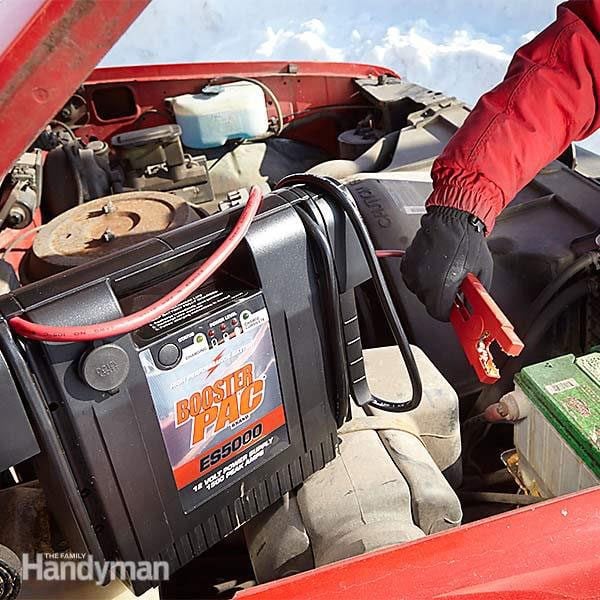
Dealing With Dead Batteries: The Latest Jump-Starting Methods
You probably keep jumper cables in your vehicle so you can solicit a jump if your battery dies or offer a jump to a fellow driver. But jumping batteries on cars built after 2000 might not be so smart. That’s because newer vehicles contain as many as a dozen computers and even more digital devices. Jump-starting with cables connected to a running vehicle can create a voltage surge large enough to fry expensive computers in either vehicle. And, since most of these components communicate on a shared data bus, surge damage to just one computer or digital device (even a radio) can disable the entire data bus, preventing the vehicle from starting and costing hundreds to diagnose and repair. Think about that: You can cause expensive damage to your own car simply by providing a jump to someone else.
Here’s the bottom line: Dealing with a dead battery in a modern vehicle requires new equipment and techniques. We’ll get you up to speed on the latest jump-starting methods and show you what new equipment you need to safely jump-start and replace an automotive battery.
Here are five ways to extend the life of your car battery.
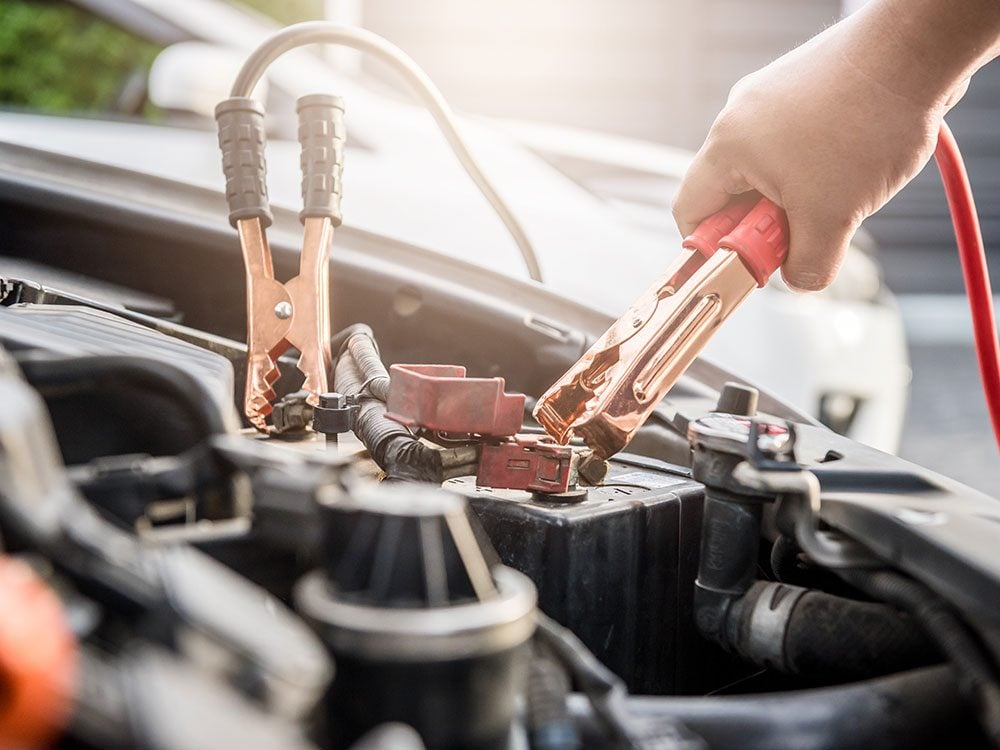
Avoiding Voltage Spikes When Jump-Starting a Car
When you connect jumper cables from a running vehicle to a dead battery, the alternator in the running vehicle instantly puts out maximum charging voltage. That can create a voltage spike of up to 15.5 volts in both vehicles. And it’s that voltage spike that can fry computers and digital devices. (Here are tips on how to fix an automotive short circuit.)
One way to eliminate the voltage spike is to leave the engine off in the donor car. That will prevent frying computers in the donor car. But if the car won’t start right up, don’t grind away to the point that you end up with dead batteries in both cars! (Check out more mistakes that shorten the life of your car.)
Jump-starting with a jumper pack (also called a booster pack or a juice pack) is a better alternative. The battery inside the jumper pack provides the boost to the dead battery at a safe voltage. When used properly, it’s the safest way to protect the electronics in the dead vehicle while providing enough boost to get the engine running.
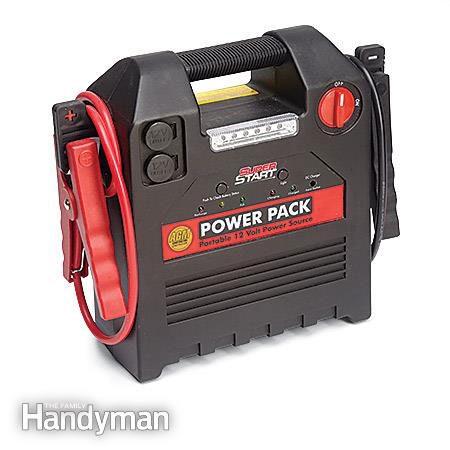
This is the Difference Between a Power Pack and Jumper Pack
Emergency portable power packs (above) and jumper packs look alike, but they’re built with different batteries. A power pack battery is designed to provide low power for long periods, while a jumper pack battery is designed to provide maximum power for short periods to start a deeply discharged vehicle battery. A power pack can usually provide enough power to jump a slightly discharged vehicle battery, but that can shorten the life of the unit.
Uses for an emergency portable power pack (above)
- Power port sockets for recharging phones and tablets during a power failure.
- Inflate a spare tire.
- Light up a work area.
- Jump a slightly discharged vehicle battery.
Uses for a jumper pack
- Jump-start a dead battery.
Here are more tips for recharging a dead car battery quickly—and safely.
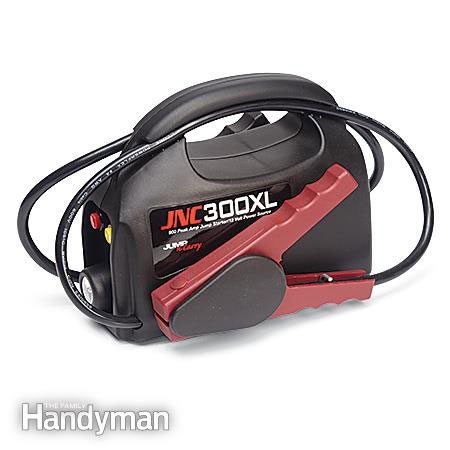
How to Jump-Start a Car With a Jump Box or Jumper Pack
First, turn off all lights and electrical accessories in the dead vehicle. Next, connect the cables the same as you would ordinary jumper cables—positive clamp to the positive battery post and negative clamp to a metallic engine component or chassis grounding point. Then try starting the vehicle. Follow the jumper pack’s instructions for maximum cranking times. If the jump works, you’re all set. If not, you tried your best and didn’t damage any electronics. (Here’s what to do the next time your car won’t start.)
Choosing A Jumper Pack
Big-box retailers and auto parts stores sell jumper packs and emergency and recreational portable power packs. Even though both have battery cables and clamps, they’re two different animals. Emergency and recreational portable power packs are designed to provide low power for long periods to get you through a power failure or provide portable power for picnics, camping or tailgating. They may start a vehicle with a slightly discharged battery, but they may not pack enough punch to jump-start a seriously discharged battery or start a vehicle that’s flooded. Packs meant for jumping, on the other hand, have batteries that’ll deliver a lot of power for short periods and are the ones to buy if emergency battery jumps are your intended purpose.
Here’s how to choose a jumper pack. First, ignore the pack’s peak amp rating. Peak amps doesn’t indicate the pack’s ability to start a vehicle. Instead, look for the unit’s cranking amps (CA) rating. You need a minimum of 225 CAs to start a four- or six-cylinder engine. (One jumper pack that meets these specs is the Clore JNC300XL.) If you have a larger engine or want more power, find a pack with 400 or more CAs. (Two examples are the Clore ES5000 and the Schumacher PSJ-3612.)
Peak Amps vs. Cranking Amps
Many manufacturers list a peak amp rating on their pack. But it’s not a reliable indicator of battery power. Instead, check for the pack’s cranking amps (CA) rating. To arrive at the CA rating, the battery is discharged for 30 seconds. The number of amps the battery delivers during that period while still maintaining at least 1.2 volts per cell is its CA rating. The higher the CA, the better the battery.
Here are seven more car maintenance jobs you can do yourself.
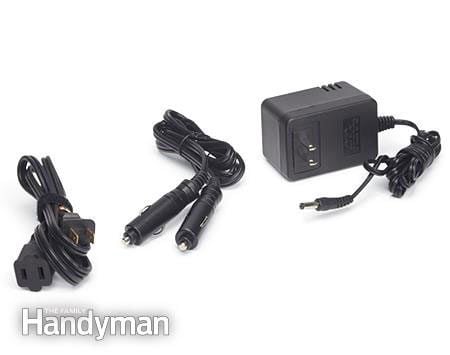
Keeping the Jumper Pack Charged
Jumper packs require regular recharging. You can’t charge a pack, throw it in your truck for six months and expect it to work when you need it. Recommendations vary, but count on recharging a jumper pack at least once every 30, 60 or 90 days. If you don’t keep the pack charged, its battery will degrade to the point that it won’t accept or hold a charge. Then you’ll have to buy a new car battery, which costs almost as much as a pack. However, if you maintain it properly, it’ll last for several years.
Jumper packs must be recharged at a very low rate (usually less than 1 amp) for long periods (usually 24 hours). The units come with a wall transformer or an AC extension cord that plugs into an internal transformer. Some packs also come with a power port adapter cable for emergency charging. Since a port outputs almost 12 amps (12 times the recommended charging rate), always follow the manufacturer’s instructions to avoid overheating the internal battery. Finally, never connect a jumper pack to the battery on a running vehicle or to an automotive battery charger. The high charging rate will destroy the jumper pack battery.
Maintaining a jumper pack is a hassle. They’re not the perfect alternative to jumper cables, just the safest. So it really comes down to this: You can drag the pack inside and charge it periodically, or you can take your chances with jumper cables. If you forget to recharge your jumper pack, you’re out about $125. If you fry an electronic component while using jumper cables, you’re looking at a minimum of $500 for a tow, diagnostic fee, labor and parts. The choice is yours.
Test Your Battery and Charging System
You can check the condition of the battery, starting and entire charging system with a computerized battery tester. One choice is the SOLAR BA9. Besides testing voltage, it tests internal resistance and the condition of the starter and alternator. This one works on conventional SLI batteries, as well as gel and absorbed glass mat (AGM), so you can also use it on motorcycle and lawn and garden equipment.
These clever car hacks make driving so much better.
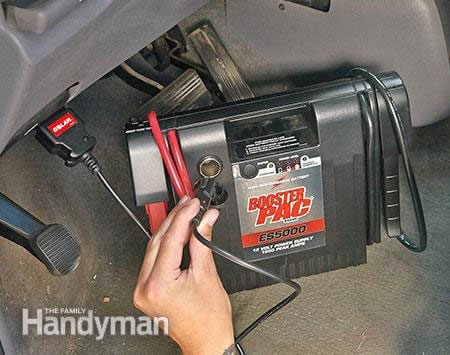
Maintaining Computer Memory When Changing The Battery
Replacing a battery in an older vehicle is simple; remove the cables and hold down and swap in the new battery. But if you’re changing a battery in a vehicle built after 2000, a jumper pack and power adapter cables are good tools to have on hand. That’s because newer vehicles require backup power (a minimum of 12 volts) to maintain the “learned” calibrations for the electronic throttle body, anti-pinch windows, power sliding door, HVAC actuators, theft-deterrent radio and security system. If you don’t provide backup power, the vehicle will “forget” the calibrations when you disconnect the old battery. Then, when you connect the new battery, the vehicle may not start or may run so poorly that it has to be towed to a shop. Some vehicles require costly ($150 and up) dealership-only recalibration with a factory scan tool. Others will run poorly until they eventually relearn.
You can avoid all those recalibration issues by providing backup power to the vehicle while you change the battery. Use your jumper pack with a special cable (SOLAR ESA30 OBD II Memory Saver Connector). Find the OBD II diagnostic port on your vehicle (usually under the dash on the driver’s side) and push the D-shape connector onto the port. Plug the other cable end into a jumper pack or emergency and recreational portable power pack. Then remove the battery cables (negative cable first) and insulate each one with electrical tape or shove them into a nonconductive cover to prevent shorting.
Next, check out nine strange car sounds—and what they could mean.